Numerical Investigation on the Yield Pillar Bearing Capacity under the Two-End-Type Cable Reinforcement
Abstract
:1. Introduction
2. Establishment of the Numerical Model
2.1. Simulation Methodology
2.2. Calibration of the Simulation Parameters
2.3. Parameters for the Yield Pillar
3. Numerical Modelling of Two-Ended Cables
3.1. Relations between Peak Strength and Two-Ended Cables
3.2. Relations between Residual Strength and Two-Ended Cables
3.3. Comparison of the Strengthening Effect of the Peak Strength and Residual Strength of Pillars under Two-End-Type Anchoring
4. Numerical Interpretation of the Support Mechanism
4.1. The Law of Support Stress Distribution with Different Two-End-Type Cable Schemes
4.2. The Two-End-Type Cable’s Support Mechanism
5. Case Study
5.1. Coal Pillar Stability Control Strategy Using a Two-End-Type Cable
- (1)
- As the row spacing of cables decreases, the proportion of the support stress zone in the coal pillar increases, and the pillar bearing capacity is significantly enhanced. However, for economic reasons, the row spacing of cables cannot be simply reduced since the reduction of the row spacing will increase the consumption of cables.
- (2)
- If an obvious rising in peak strength is taken as target, simply increasing the strength of the cable support is not sufficient. In all cases, the pillar peak strength increase is less than 5%.
- (3)
- As the width of the pillar falls, the ratio of residual/peak strength decreases, indicating the failure of the narrower pillars can be more violent. When the support density of the cable increases, the residual/peak strength ratio increases, which effectively improves the failure features of the pillar and avoids the violent failure of the pillar.
- (4)
- To study the two-end-type cable reinforcement, the bolt support reinforcement on the pillar was neglected in this research. However, in an actual production process, the reinforcement of bolt support on the yielding pillar cannot be ignored. Figure 10 reveals that although the coal pillar strength was increased slightly by bolt support alone, the effect of a combined bolt and cable support improved its strength greatly, often by more than the sum of the two. Therefore, the combined support effect of bolts and cables should be involved in designing coal pillar reinforcement support schemes.
5.2. Technical Measures of Reinforced Support
5.3. Application Effect
6. Conclusions
- (1)
- The w/h ratio of coal pillars and the supporting power of bi-terminal cables played a significant role in enhancing the load-bearing ability of yield coal pillars. With augmented support strength, there was a notable rise in both peak and residual strengths across the coal pillar models. Interestingly, as the w/h ratios grew, there was a pronounced increase in peak strength, whereas the rise in residual strength was less evident.
- (2)
- Due to the effect of pretensioning, two pronounced zones of support stress were apparent at either end of the cable. In the intervening space, the stress diminished proportionately the farther it was from either end. However, different row spacings exhibited varied stress distributions, which could influence the bearing capacity. Smaller spacings resulted in more extensive support stress, which in turn positively affected the radial stresses and improved the pillar’s stress conditions.
- (3)
- Observations from field monitoring revealed that when mining advanced in the 8311 working face towards the measuring point, the convergence measurements in the ribs of the coal pillars for the 2311 and 2312 roadways were 72 mm and 65 mm, respectively. This suggests an overall expansion deformation of 137 mm, translating to a deformation magnitude of around 2.28%. Such findings confirm the yield coal pillar’s stability during the mining operations of the 8311 panel.
Author Contributions
Funding
Data Availability Statement
Conflicts of Interest
References
- Chang, Q.; Ge, S.; Shi, X.; Sun, Y.; Wang, H.; Li, M.; Wang, Y.; Wu, F. Determination of Narrow Coal Pillar Width and Roadway Surrounding Rock Support Technology in Gob Driving Roadway. Sustainability 2022, 14, 4848. [Google Scholar] [CrossRef]
- Liu, H.-Q.; Wang, L.; Han, L.-C.; Liu, P.; Zou, P.; Liu, X. Study on the Instability Mechanism and Control Measures of a Roadway in a Mine with Retained Coal Pillars and Close Coal Seams. Shock Vib. 2021, 2021, 8871807. [Google Scholar] [CrossRef]
- Li, Z.; Yang, K.; Ji, J.; Jiao, B.; Tian, X.; Zhang, J. Analysis on Rock Burst Risks and Prevention of a 54 m-Wide Coal Pillar for Roadway Protection in a Fully Mechanized Top-Coal Caving Face. Shock Vib. 2021, 2021, 5584411. [Google Scholar] [CrossRef]
- Wang, Q.; Feng, H.; Tang, P.; Peng, Y.; Li, C.; Jiang, L.; Mitri, H.S. Influence of Yield Pillar Width on Coal Mine Roadway Stability in Western China: A Case Study. Processes 2022, 10, 251. [Google Scholar] [CrossRef]
- Wang, W.; Wu, Y.; Lu, X.; Zhang, G. Study on small coal pillar in gob-side entry driving and control technology of the sur-rounding rock in a high-stress roadway. Front. Earth Sci. 2023, 10, 221–226. [Google Scholar] [CrossRef]
- Zhang, S.; Wang, X.; Fan, G.W.; Zhang, D.; Jianbin, C. Pillar size optimization design of isolated island panel gob-side entry driving in deep inclined coal seam—Case study of Pingmei No. 6 coal seam. J. Geophys. Eng. 2018, 15, 816–828. [Google Scholar] [CrossRef]
- Su, M.; Gao, X. Research of the Surrounding Rock Deformation Control Technology in Roadway under Multiple Excavations and Mining. Shock Vib. 2021, 2021, 6681184. [Google Scholar] [CrossRef]
- Wang, D.; He, F.; Wu, Y.; Xu, X.; Zhang, J.; Lv, K.; Li, L.; Zhai, W.; Song, J. Study on surrounding rock failure mechanism and rational coal pillar width of the gob-side coal roadway under influence of intense dynamic pressure. Energy Sci. Eng. 2023, 11, 1716–1733. [Google Scholar] [CrossRef]
- Xie, S.; Guo, F.; Wu, Y. Control Techniques for Gob-Side Entry Driving in an Extra-Thick Coal Seam with the Influence of Upper Residual Coal Pillar: A Case Study. Energies 2022, 15, 3620. [Google Scholar] [CrossRef]
- Li, X.; Zhao, Y.; He, W.; Li, L.; He, F. Study on Coal Pillar Width and Surrounding Rock Control of Gob-Side Entry in Extra-thick Coal Seam. Geotech. Geol. Eng. 2020, 38, 6855–6868. [Google Scholar] [CrossRef]
- Gong, S.; Tan, Y.; Liu, Y.; Zhu, D.; Yu, Y.; Song, Z. Application of Presplitting Blasting Technology in Surrounding Rock Control of Gob-Side Entry Retaining with Hard Roof: A Case Study. Adv. Mater. Sci. Eng. 2021, 2021, 1318975. [Google Scholar] [CrossRef]
- Zhang, G.C.; Wen, Z.J.; Liang, S.J.; Tan, Y.L.; Tian, L.; Zhao, Y.Q.; Zhao, D.S. Ground Response of a Gob-side Entry in a Longwall Panel Extracting 17 m-Thick Coal Seam: A Case Study. Rock Mech. Rock Eng. 2019, 53, 497–516. [Google Scholar] [CrossRef]
- Wu, R.; He, Q.; Oh, J.; Li, Z.; Zhang, C. A New Gob-Side Entry Layout Method for Two-Entry Longwall Systems. Energies 2018, 11, 2084. [Google Scholar] [CrossRef]
- Wang, M.; Xu, Y.; Xu, Q.; Shan, C.; Li, Z.; Nan, H.; Li, Y.; Liu, H.; Chu, T. Stability control of overburden and coal pillars in the gob-side entry under dynamic pressure. Int. J. Rock Mech. Min. Sci. 2023, 170, 105490. [Google Scholar] [CrossRef]
- Liu, Q.; Ling, H.; Lu, Y.; Lin, J.; Liu, Y.; Wang, J.; Huang, W.; Wang, L.; Yin, Z. Residual Strength Estimation Method of Soft Coal Based on Equivalent Residual Strain Ratio. Geofluids 2022, 2022, 8079568. [Google Scholar] [CrossRef]
- Liu, X.; Shen, W.; Bai, J.; Wang, R.; Kang, J.; Wang, X.; Zhu, Z. Mining-Induced Redistribution of the Abnormal Stress under the Close Bearing Coal Pillar for Entry Design. Adv. Civ. Eng. 2021, 2021, 5595372. [Google Scholar] [CrossRef]
- Han, P.; Zhang, C.; Wang, W. Failure analysis of coal pillars and gateroads in longwall faces under the mining-water invasion coupling effect. Eng. Fail. Anal. 2021, 131, 105912. [Google Scholar] [CrossRef]
- Ren, J.; Zhao, Y.; Wang, W.; Guo, J.; Sun, Z.; Liu, S. Optimal Design of a Protective Coal Pillar with a Buried Pipeline in a Thick Loose Layer in Western China: Methodology and Case Study. Rock Mech. Rock Eng. 2023, 56, 2879–2896. [Google Scholar] [CrossRef]
- Yue, X.; Tu, M.; Li, Y.; Chang, G.; Li, C. Stability and Cementation of the Surrounding Rock in Roof-Cutting and Pressure-Relief Entry under Mining Influence. Energies 2022, 15, 951. [Google Scholar] [CrossRef]
- Yang, S.; Ning, J.; Gao, M.; Wang, J.; Shi, X.; Hu, S.; Li, Y. Instability mechanism and stability control of gob-side entry in a deep mine: A case study. Bull. Eng. Geol. Environ. 2023, 82, 346. [Google Scholar] [CrossRef]
- Hou, C.; Zhu, W.-C.; Yan, B.-X.; Yang, L.-J.; Du, J.-F.; Niu, L.-L. Mechanical behavior of backfilled pillar under biaxial loading. J. Central South Univ. 2023, 30, 1191–1204. [Google Scholar] [CrossRef]
- Qu, X.; Chen, Y.; Yin, D. Experimental study on progressive failure characteristics of strip coal pillar models under different roof and floor conditions. Case Stud. Constr. Mater. 2023, 18, e02147. [Google Scholar] [CrossRef]
- Sahoo, S.K.; Singh, G.S.P.; Sharma, S.K.; Singh, U.K. Numerical Modeling Study of the Influence of Softcover on Strata and Support Behavior in a Bord and Pillar Depillaring Working. Min. Metall. Explor. 2020, 37, 1151–1168. [Google Scholar] [CrossRef]
- Abousleiman, R.; Walton, G.; Sinha, S. Understanding roof deformation mechanics and parametric sensitivities of coal mine entries using the discrete element method. Int. J. Min. Sci. Technol. 2020, 30, 123–129. [Google Scholar] [CrossRef]
- Li, L.; Li, G.; Gong, W.; Wang, J.; Deng, H. Energy Evolution Pattern and Roof Control Strategy in Non-Pillar Mining Method of Goaf-Side Entry Retaining by Roof Cutting—A Case Study. Sustainability 2019, 11, 7029. [Google Scholar] [CrossRef]
- Mo, S.; Canbulat, I.; Zhang, C.; Oh, J.; Shen, B.; Hagan, P. Numerical investigation into the effect of backfilling on coal pillar strength in highwall mining. Int. J. Min. Sci. Technol. 2017, 28, 281–286. [Google Scholar] [CrossRef]
- Das, A.J.; Mandal, P.K.; Paul, P.S.; Sinha, R.K.; Tewari, S. Assessment of the Strength of Inclined Coal Pillars through Nu-merical Modelling based on the Ubiquitous Joint Model. Rock Mech. Rock Eng. 2019, 52, 3691–3717. [Google Scholar]
- Zhang, G.-C.; Tan, Y.-L.; Liang, S.-J.; Jia, H.-G. Numerical Estimation of Suitable Gob-Side Filling Wall Width in a Highly Gassy Longwall Mining Panel. Int. J. Géoméch. 2018, 18, 04018091.1–04018091.15. [Google Scholar] [CrossRef]
- Wang, C.; Lu, Y.; Shen, B.; Li, Y.; Liang, Y. Design and monitoring of CPB replacement mining RSCP: A case study in China. Energy Sources Part A Recover. Util. Environ. Eff. 2019, 43, 80–95. [Google Scholar] [CrossRef]
- Jiang, Y.; Zhao, Y.; Wang, H.; Zhu, J. A review of mechanism and prevention technologies of coal bumps in China. J. Rock Mech. Geotech. Eng. 2017, 9, 180–194. [Google Scholar] [CrossRef]
- Lv, J.; Wan, Z.; Zhang, Y.; Wang, J.; Yan, W.; Xiong, L. Effect of multi-factor dynamic loading on gob-side entry driving during longwall face extraction: A case study. Bull. Eng. Geol. Environ. 2022, 81, 409. [Google Scholar] [CrossRef]
- Zhao, P.; Zhang, W.; Li, S.; Chang, Z.; Lu, Y.; Cao, C.; Shi, Y.; Jia, Y.; Lou, F.; Wei, Z.; et al. Numerical Simulation Study on Mechanical Characteristics and Width Optimization of Narrow Coal Pillar in Gob-Side Coal Seam Tunnel. Sustainability 2022, 14, 16014. [Google Scholar] [CrossRef]
- Yang, R.; Zhu, Y.; Li, Y.; Li, W.; Lin, H. Coal pillar size design and surrounding rock control techniques in deep longwall entry. Arab. J. Geosci. 2020, 13, 453. [Google Scholar] [CrossRef]
- Xu, J.; Li, G.; Gomah, M.E.; Chen, B.; Sun, C.; Rong, H.; Zhang, Q. Overlying main roof breaking characteristic and its effect on the stability of gob-side entry. Géoméch. Geophys. Geo-Energy Geo-Resources 2023, 9, 1–15. [Google Scholar] [CrossRef]
- Yang, Y.; Zhang, Y.; Shen, W. Research on the Technology of Small Coal Pillars of Gob-Side Entry Retained in Deep Mines Based on the Roof Cutting for Pressure Unloading in the Lower Key Stratum. Geofluids 2022, 2022, 7701154. [Google Scholar] [CrossRef]

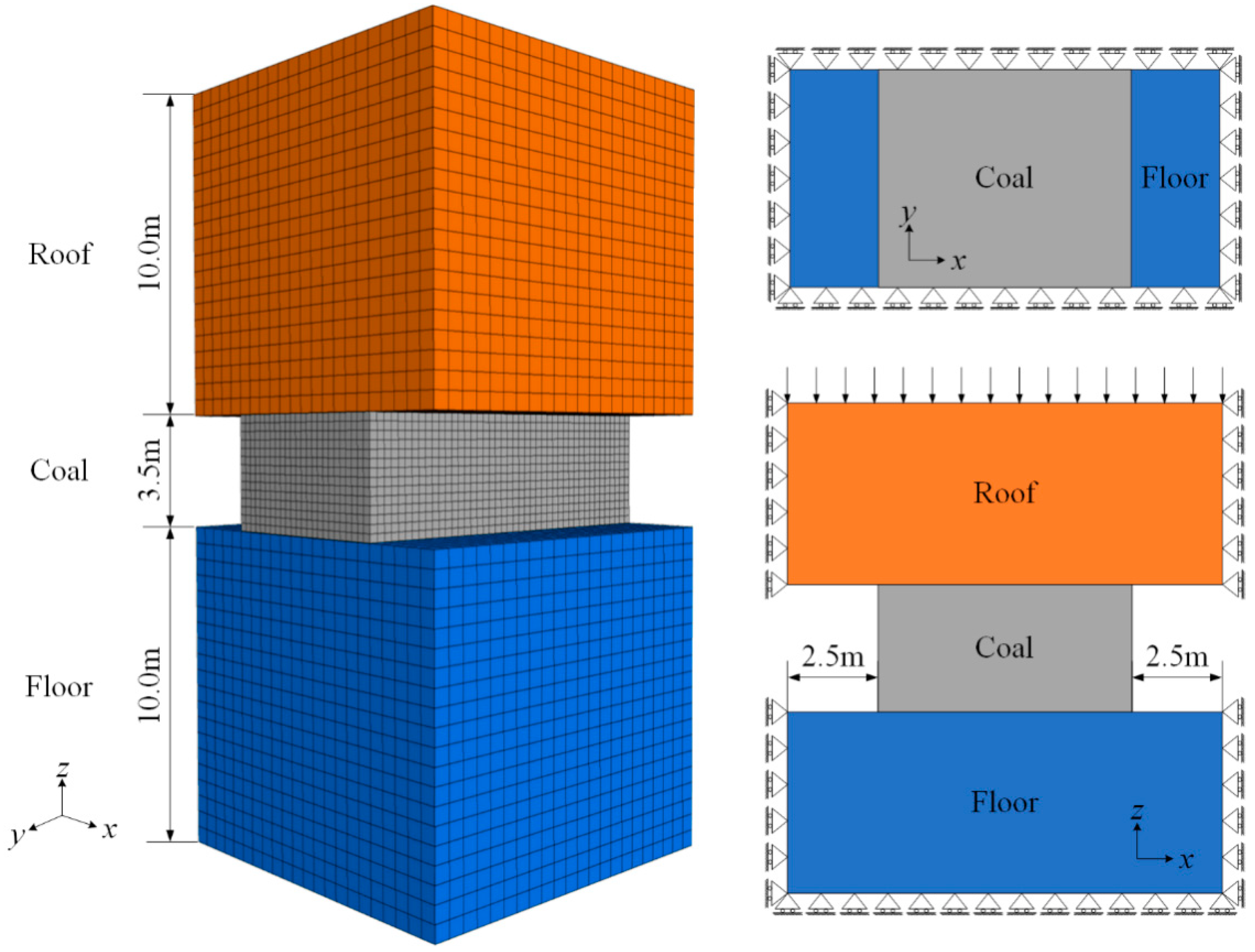
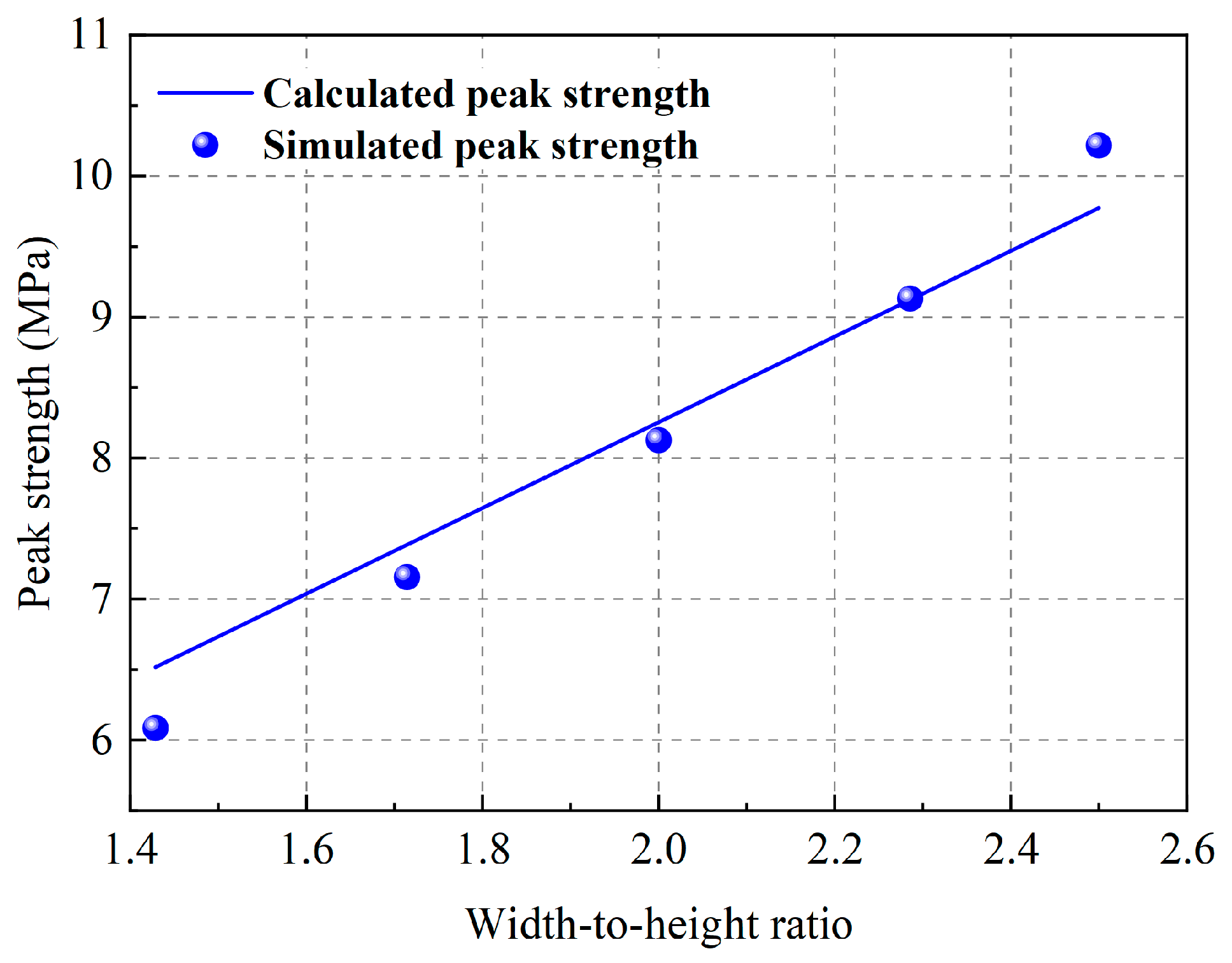

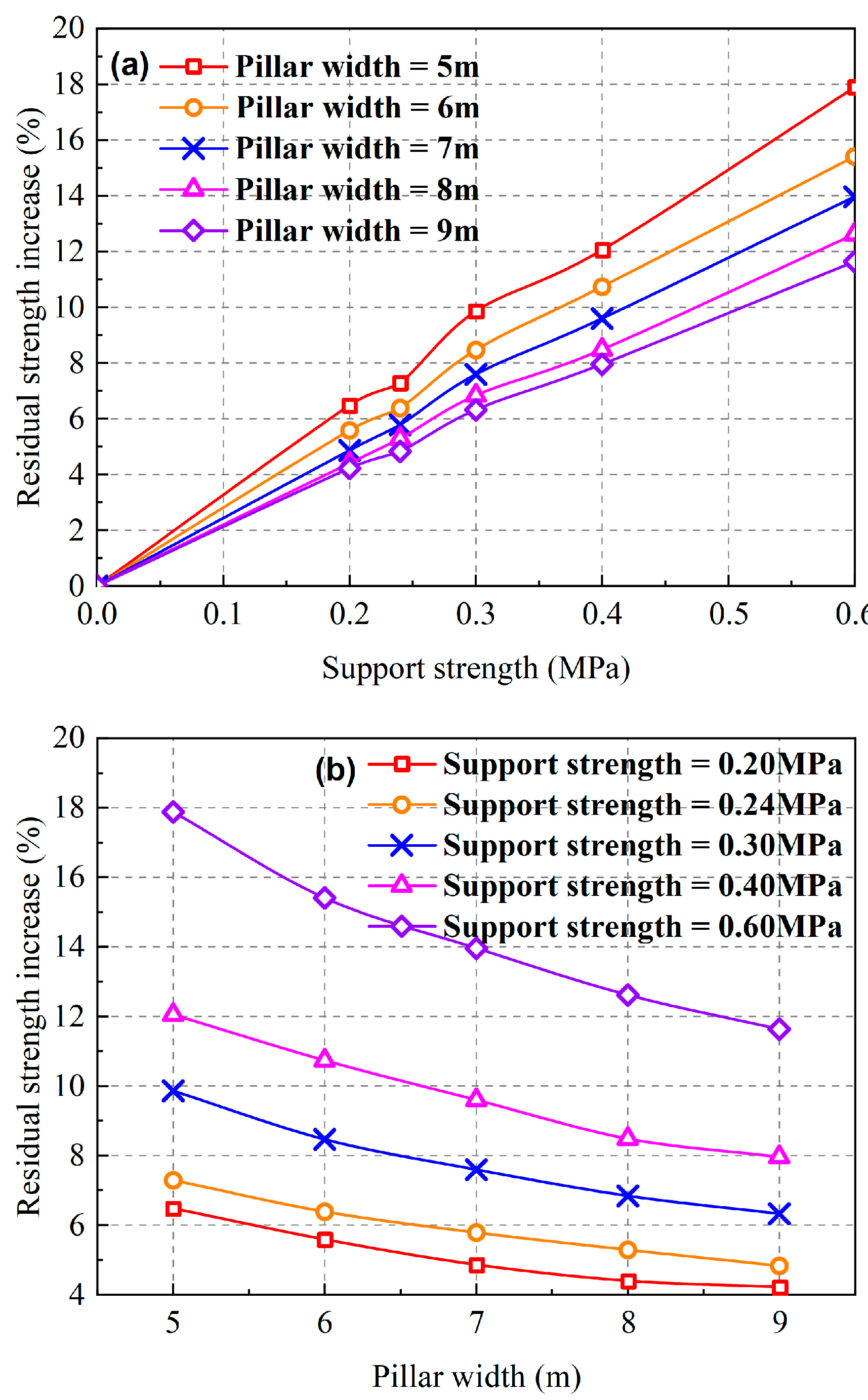


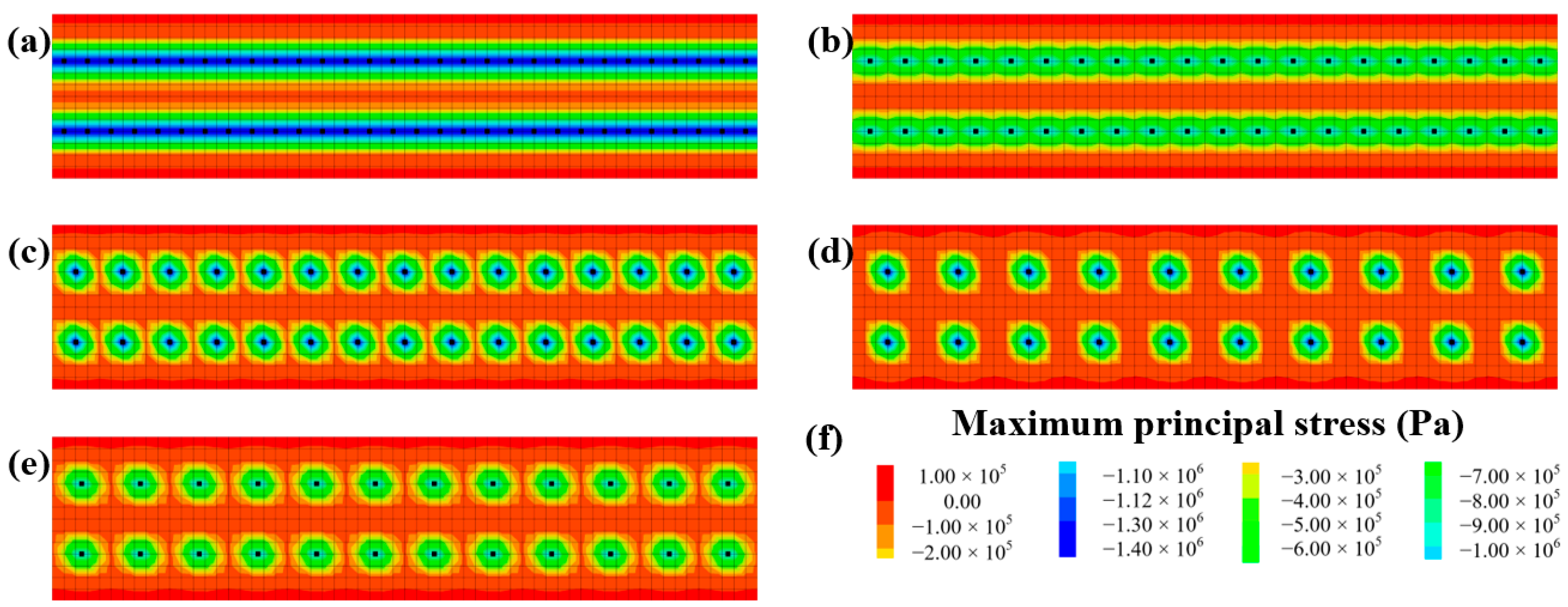
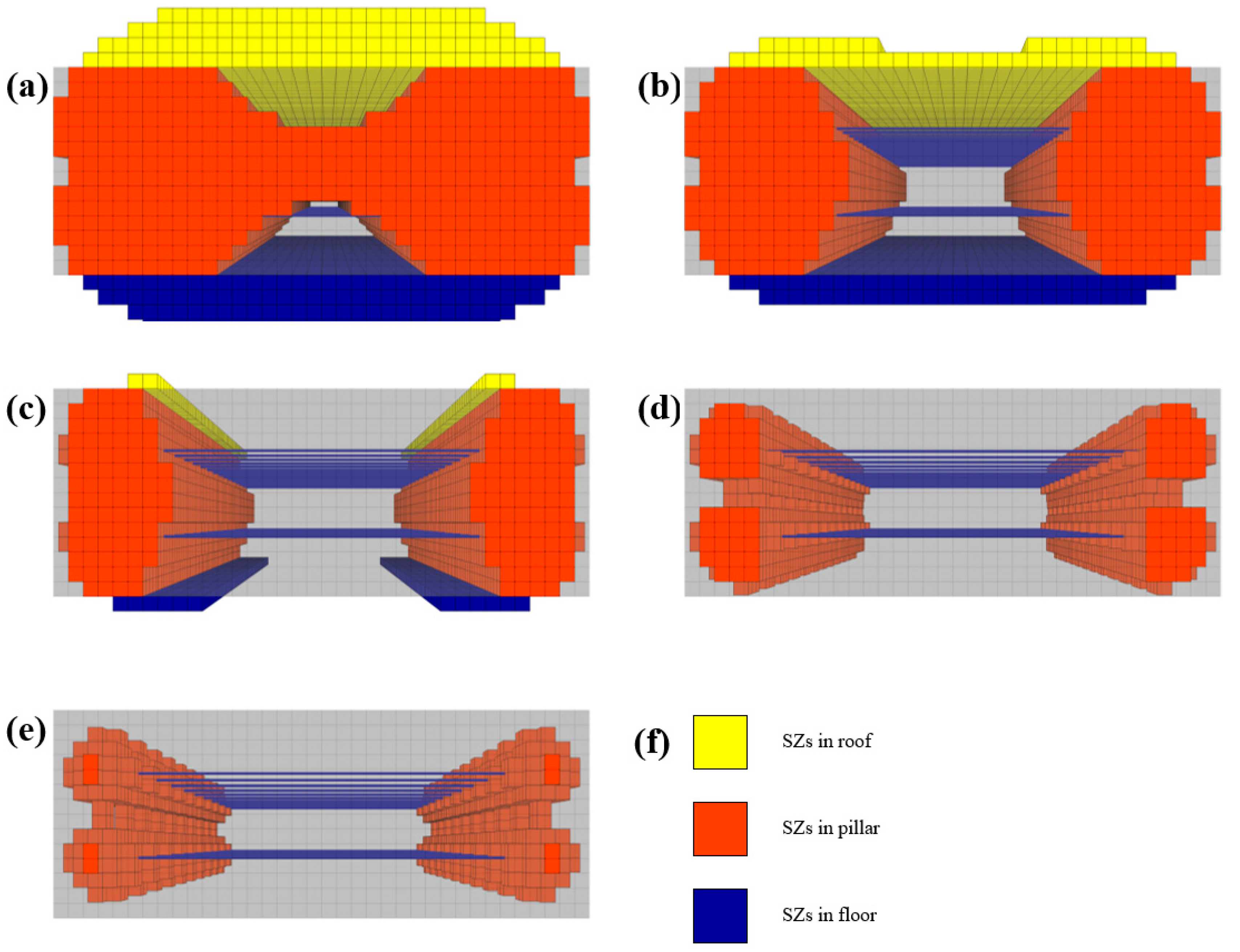
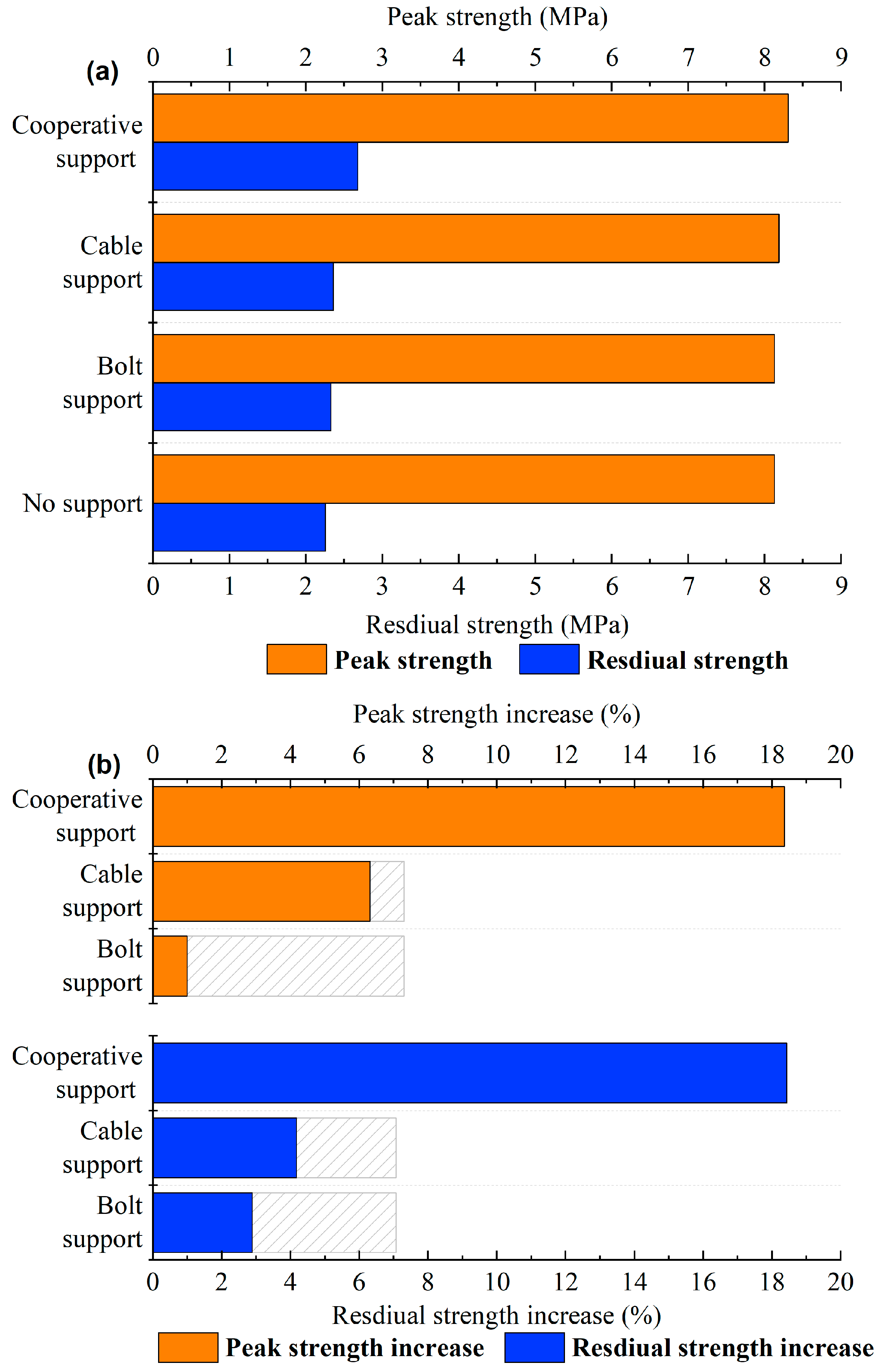


| Lithology | Thickness (m) | Density (kg·m−3) | Bulk Modulus (GPa) | Shear Modulus (GPa) | Cohesion (MPa) | Friction Angle (°) | Tensile Strength (MPa) |
|---|---|---|---|---|---|---|---|
| Roof | 10.0 | 2500 | 14.00 | 11.51 | 4.5 | 43 | 4.7 |
| 4 coal | 3.4 | 1500 | 0.91 | 0.42 | 3.29 | 30 | 0.7 |
| Floor | 10.0 | 2500 | 14.00 | 8.40 | 3.8 | 40 | 4.7 |
| Interface | Normal stiffness = 100 GPa/m; shear stiffness = 50 GPa/m; Interface cohesion = 0.795 MPa; internal friction angle = 31° | ||||||
| Plastic Strain | 0 | 0.005 | 0.05 | 1 |
|---|---|---|---|---|
| Cohesion (MPa) | 3.29 | 1.97 | 0.66 | 0.66 |
| Friction angle (°) | 30 | 22 | 18 | 18 |
| Pillar Strength | Row Spacing (m) | Support Strength (MPa) | Pillar Height (m) | ||||
|---|---|---|---|---|---|---|---|
| 5.0 (w/h = 1.43) | 6.0 (w/h = 1.71) | 7.0 (w/h = 2.0) | 8.0 (w/h = 2.28) | 9.0 (w/h = 2.57) | |||
| Peak strength (MPa) | N/A | 0 | 6.09 | 7.16 | 8.13 | 9.13 | 10.29 |
| 1.50 | 0.20 | 6.14 | 7.26 | 8.21 | 9.23 | 10.41 | |
| 1.25 | 0.24 | 6.15 | 7.28 | 8.23 | 9.25 | 10.44 | |
| 1.00 | 0.30 | 6.18 | 7.31 | 8.26 | 9.29 | 10.49 | |
| 0.75 | 0.40 | 6.21 | 7.34 | 8.31 | 9.37 | 10.57 | |
| 0.5 | 0.60 | 6.26 | 7.41 | 8.41 | 9.50 | 10.74 | |
| Residual strength (MPa) | N/A | 0 | 1.38 | 1.79 | 2.27 | 2.76 | 3.26 |
| 1.50 | 0.20 | 1.47 | 1.89 | 2.38 | 2.88 | 3.40 | |
| 1.25 | 0.24 | 1.48 | 1.91 | 2.40 | 2.90 | 3.42 | |
| 1.00 | 0.30 | 1.52 | 1.95 | 2.44 | 2.95 | 3.47 | |
| 0.75 | 0.40 | 1.55 | 1.99 | 2.49 | 2.99 | 3.52 | |
| 0.5 | 0.60 | 1.63 | 2.07 | 2.58 | 3.11 | 3.64 | |
| Residual/peak strength ratio (%) | N/A | 0 | 22.66 | 25.00 | 27.92 | 30.23 | 31.68 |
| 1.50 | 0.20 | 23.94 | 26.03 | 28.99 | 31.20 | 32.66 | |
| 1.25 | 0.24 | 24.07 | 26.24 | 29.16 | 31.35 | 32.76 | |
| 1.00 | 0.30 | 24.60 | 26.68 | 29.54 | 31.75 | 33.08 | |
| 0.75 | 0.40 | 24.96 | 27.11 | 29.96 | 31.91 | 33.30 | |
| 0.5 | 0.60 | 26.04 | 27.94 | 30.68 | 32.74 | 33.89 | |
| Row Spacing (m) | SZs in the Pillars | Percentage of SZs in the Pillar Zones (%) |
|---|---|---|
| 0.50 | 21,600 | 91.84 |
| 0.75 | 17,480 | 74.32 |
| 1.00 | 10,440 | 44.39 |
| 1.25 | 5856 | 24.90 |
| 1.50 | 2720 | 11.56 |
Disclaimer/Publisher’s Note: The statements, opinions and data contained in all publications are solely those of the individual author(s) and contributor(s) and not of MDPI and/or the editor(s). MDPI and/or the editor(s) disclaim responsibility for any injury to people or property resulting from any ideas, methods, instructions or products referred to in the content. |
© 2023 by the authors. Licensee MDPI, Basel, Switzerland. This article is an open access article distributed under the terms and conditions of the Creative Commons Attribution (CC BY) license (https://creativecommons.org/licenses/by/4.0/).
Share and Cite
Shan, C.; Cao, S.; Zhang, Z.; Lin, K.; Sun, J. Numerical Investigation on the Yield Pillar Bearing Capacity under the Two-End-Type Cable Reinforcement. Energies 2023, 16, 6418. https://doi.org/10.3390/en16186418
Shan C, Cao S, Zhang Z, Lin K, Sun J. Numerical Investigation on the Yield Pillar Bearing Capacity under the Two-End-Type Cable Reinforcement. Energies. 2023; 16(18):6418. https://doi.org/10.3390/en16186418
Chicago/Turabian StyleShan, Changhao, Shenggen Cao, Zeyu Zhang, Kewen Lin, and Jialong Sun. 2023. "Numerical Investigation on the Yield Pillar Bearing Capacity under the Two-End-Type Cable Reinforcement" Energies 16, no. 18: 6418. https://doi.org/10.3390/en16186418






